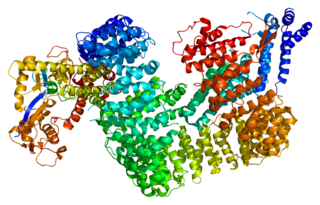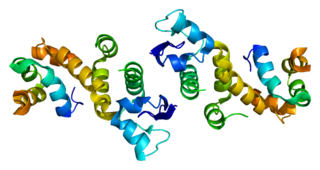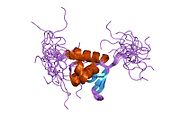
Cullin 1, also known as CUL1, is a human protein and gene from cullin family. This protein plays an important role in protein degradation and protein ubiquitination.

26S proteasome non-ATPase regulatory subunit 10 or gankyrin is an enzyme that in humans is encoded by the PSMD10 gene. First isolated in 1998 by Tanaka et al.; Gankyrin is an oncoprotein that is a component of the 19S regulatory cap of the proteasome. Structurally, it contains a 33-amino acid ankyrin repeat that forms a series of alpha helices. It plays a key role in regulating the cell cycle via protein-protein interactions with the cyclin-dependent kinase CDK4. It also binds closely to the E3 ubiquitin ligase MDM2, which is a regulator of the degradation of p53 and retinoblastoma protein, both transcription factors involved in tumor suppression and found mutated in many cancers. Gankyrin also has an anti-apoptotic effect and is overexpressed in certain types of tumor cells such as hepatocellular carcinoma.

COP9 signalosome complex subunit 6 is a protein that in humans is encoded by the COPS6 gene.

COP9 constitutive photomorphogenic homolog subunit 5 (Arabidopsis), also known as COPS5 or Csn5, is a gene conserved from humans to Saccharomyces cerevisiae.

Proteasome activator complex subunit 3 is a protein that in humans is encoded by the PSME3 gene.

COP9 signalosome complex subunit 2 is a protein that in humans is encoded by the COPS2 gene. It encodes a subunit of the COP9 signalosome.

Cullin-2 is a protein that in humans is encoded by the CUL2 gene.

Cullin 3 is a protein that in humans is encoded by the CUL3 gene.

COP9 signalosome complex subunit 3 is a protein that in humans is encoded by the COPS3 gene. It encodes a subunit of the COP9 signalosome.

COP9 signalosome complex subunit 8 is a protein that in humans is encoded by the COPS8 gene.

COP9 signalosome complex subunit 1 is a protein that in humans is encoded by the GPS1 gene.

Anaphase-promoting complex subunit 2 is an enzyme that in humans is encoded by the ANAPC2 gene.

Dolichyl-diphosphooligosaccharide—protein glycosyltransferase subunit 1 is an enzyme that in humans is encoded by the RPN1 gene.

Proteasomal ubiquitin receptor ADRM1 is a protein that in humans is encoded by the ADRM1 gene. Recent evidences on proteasome complex structure confirmed that the protein encoded by gene ADRM1, also known in yeast as 26S Proteasome regulatory subunit Rpn13, is a subunit of 19S proteasome complex.

COP9 signalosome complex subunit 7a is a protein that in humans is encoded by the COPS7A gene.

Cullin-associated NEDD8-dissociated protein 1 is a protein that in humans is encoded by the CAND1 gene.

Alpha-S1-casein is a protein that in humans is encoded by the CSN1S1 gene.

COP9 signalosome complex subunit 7b is a protein that in humans is encoded by the COPS7B gene.

S-phase kinase-associated protein 1 is an enzyme that in humans is encoded by the SKP1 gene.

COP9 signalosome (CSN) is a protein complex with isopeptidase activity. It catalyses the hydrolysis of NEDD8 protein from the cullin subunit of Cullin-RING ubiquitin ligases (CRL). Therefore, it is responsible for CRL deneddylation – at the same time, it is able to bind denedyllated cullin-RING complex and retain them in deactivated form. COP9 signalosome thus serves as a sole deactivator of CRLs. The complex was originally identified in plants, and subsequently found in all eukaryotic organisms including human. Human COP9 signalosome consists of 8 subunits - CSN1, CSN2, CSN3, CSN4, CSN5, CSN6, CSN7, CSN8. All are essential for full function of the complex and mutation in some of them is lethal in mice.























